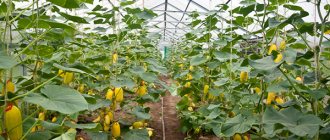The business of growing greenery attracts, first of all, those who have a dacha or a house with a plot of land and want to receive additional income from their land. Such novice entrepreneurs proceed from the fact that setting up a business will require virtually no investment, and greens are the most profitable farm product. However, this approach is only one of the possible ones. In addition to the garden plot, greens can be grown on an industrial scale. This will require start-up capital and an established sales market, but this is the kind of business that will bring truly big profits to the entrepreneur.
Benefits and possible risks
Profitability is assessed based on the scale of the business. For large and successful entrepreneurs with an established sales market, it reaches 65%; at the initial stage it is 20-30%; on average - a little more than 40%. Among the advantages are:
- inexpensive planting material;
- ease of cultivation and unpretentiousness of crops;
- year-round demand, increasing in winter and spring;
- compactness: does not require large areas or expensive equipment;
- quick payback;
- the ability to harvest 4-5 harvests per year.
However, building a business on greenery is risky because:
- high production costs;
- products are not stored for long;
- the crop may die from diseases and pests;
- The costs of heating greenhouses are significant.
Interesting direction for business?
Not really
Market and competitor analysis
Analyze the market situation and competitors’ offers yourself or involve professionals from consulting companies (if you have the funds for this).
Market analysis implies:
- determining the number of competitors in the regional market;
- studying their range and price offers;
- determination of demand in different periods of the year;
- identifying risks and pitfalls.
Competitor analysis:
- determining the number of competitors and the “style” of their work (seasonal, permanent);
- analysis of pricing principles;
- study of the assortment.
According to the consulting company, as of December 2020, the harvest of greenhouse vegetables and salad crops was 3 times higher than the yield of the agro-industrial complex. In 2020, greenhouse areas in Russia increased by 200 hectares. The growth of the industry is associated with restrictions on imports and increased investment.
What you need to start a business
You need to decide on your goal: to grow greens mainly for yourself, selling the surplus, or to work on an industrial scale. In the first case, there is no need to talk about income: revenue will hardly cover expenses.
Plants can be planted in natural soil (sometimes in sawdust) or grown hydroponically. Hydroponics is the cheapest method (not counting the cost of the system itself), in which plants are immersed with their roots not in the ground, but in a nutrient solution.
Hydroponic plants grow quickly and look beautiful. Containers with them can be placed one above the other and even vertically on walls, which allows you to grow a large crop in a small area.
However, such greens do not have a specific taste and aroma. It will be possible to sell it only in winter, when the buyer will not have natural alternatives. We recommend another direction for business: growing champignons for sale
To grow greens you will need:
- Insulation: film, polystyrene foam, foil (for indoor growing).
- Soil, fertilizers and planting material.
- Containers: pots, boxes, pallets, water bottles.
- Thermometer for monitoring air temperature.
There are several places where you can grow herbs for sale:
- in the apartment;
- in open ground;
- in the basement;
- in the garage;
- in the greenhouse.
Growing greens at home allows you to get a small amount of harvest all round
year. Plants will need a place away from radiators and artificial lighting. The same goes for basement growing. You can't make much money this way.
One option: sow plants in open ground or a greenhouse in the summer, and move them indoors in the winter. But the most effective way of growing is a greenhouse.
A favorable microclimate is always maintained in the greenhouse. Its design allows you to conveniently fertilize the beds and harvest the crop. In addition, plants are comfortable in heated greenhouses even in winter.
Businessvsele.ru also recommends:
- Business idea: growing oyster mushrooms;
- Growing potatoes for sale;
- How to organize a business for growing seedlings.
Features of growing parsley in a greenhouse in winter
Forcing parsley in a greenhouse in winter is not an easy task. There is difficulty not only in the growing process, but also in organizing the sale of cut greens. But such a business also has many advantages.
Advantages
Greens are good for health, and consuming them in winter allows a person not to get sick and maintains a vitamin boost. Parsley is in demand all year round , so the main advantage of growing this crop in a greenhouse is the ability to harvest all year round, not only for personal use, but also for sale.
Other advantages:
- low incidence and resistance to pests;
- greens are easy to care for;
- the germination period is short, profit can be made quickly;
- the cost of fresh greens in winter is much higher than the funds spent on purchasing seeds and care;
- in the southern regions, greens are grown even in an unheated greenhouse.
Flaws
Where troubles might lie:
- Cut parsley begins to lose vitamins after 2 hours, and after 3-4 hours it withers outdoors or indoors. You need to store greens in a bag or container in the refrigerator or urgently look for a place to sell.
- If the greenhouse is located in an area with a harsh climate, it will have to be heated in order to harvest crops from autumn to spring. The price of heating appliances and electricity charges will be very significant.
- The business of selling greens is developed throughout the country. Store shelves are filled with different varieties of parsley all year round. In some regions it is difficult to enter the product market with this production; you need to look for regular customers.
Types of greenhouses
The business plan will be built and adjusted based on the characteristics of the greenhouse.
The type of heating is selected depending on the available fuel resources and the thermal conductivity of the greenhouse material (the higher the thermal conductivity, the more productive the heating system should be).
Reference! Some entrepreneurs install wood stoves for heating and solar panels to provide electricity.
A lighting system and a well-functioning irrigation system are also required. For lighting, fluorescent lamps are preferable.
A watering system is required to minimize manual labor. The most affordable is a mass watering system. A more expensive and effective option is a drip irrigation system. Advanced farmers will benefit from hydrogel, a productive and cost-effective technology for preserving moisture.
Depending on the type of greenhouse covering, there are:
- Glass. Strong, durable, transmits color well. The main disadvantage is that they cause plants to get sunburned. Also, such greenhouses do not retain heat well, which makes them unprofitable in winter.
- Polyethylene. In polyethylene greenhouses, plants are not afraid of burns, but they receive much less light. In addition, film shelters are short-lived. The only advantages are low cost and ease of use and installation.
- Acrylic/polycarbonate. Quite expensive, but effective option.
- Greenhouses—thermoses. The design of such greenhouses provides for a double covering, which allows minimizing heating costs. In mid-February, the greenhouse is cleared of snow and lined with black film. The soil will warm up sufficiently by the beginning of March.
What is the essence of business
Each seed contains a huge amount of microelements aimed at quickly turning into a full-fledged plant in favorable conditions. This entire vitamin set passes into thin stems and first leaves when the seed germinates.
Microgreen sprouts are much healthier than regular “adult” greens, since they contain a higher concentration of microelements. In addition, they only require 5-8 days to grow, whereas the full growth cycle of lettuce or cabbage takes weeks.
Due to the above benefits, microgreens are gaining popularity in big cities. Entrepreneurs create mini-farms right in their apartments, equipping shelves with containers and special lighting. Products are sold in batches every week and quickly distributed to private customers and catering establishments.
Material on the topic: profitable business ideas with minimal investment to start.
What plants are more profitable to grow?
The basis of the business is growing dill and onions. These are the most popular and profitable
plants. It is also advisable to plant:
- parsley (leaf, because root parsley is not in demand);
- salad (green and leafy, watercress);
- spinach;
- cilantro;
- sorrel;
- celery (leaf, root and stalk).
Before sowing, the seeds are briefly soaked in water. Planted in rows (in conditions of limited space - in a checkerboard pattern) to a depth of no more than three centimeters. The sowing density indicated on the packaging must be observed.
Advice! Give preference to ultra-early and early ripening varieties.
Before purchasing seeds, you need to read reviews regarding a particular variety. Well proven: Uzbek dill, Prima and Curly parsley, Vulcan onion, Curly celery, Lolla Rossa and New Year's lettuce.
Expert opinion
Alexey Matveev
Expert of our site. An experienced specialist in various fields of agriculture, as well as organizing business processes.
Ask a Question
There are several varieties of onions: hot, sweet and semi-sharp. Acute is the fastest to ripen, but is not suitable for pen. Sweet takes a long time to ripen. Semi-sharp onions are the golden mean, allowing you to grow both greens and bulbs.
After receiving the first harvest, you can grow the seeds yourself, changing the variety every two to three years to avoid degeneration.
Greens require less attention than vegetables or fruits. Many varieties are resistant to cold. But minimal care is required: watering, loosening, weeding and fertilizing. The landing order should also be observed. With rational crop rotation, after one plant is harvested, another is planted in its place.
Here are some tables to help guide you when boarding.
Table 1. Dill planting dates
| Sowing time | Harvest time |
| from 1 to 5 March | from 15 to 20 April |
| from 15 to 20 April | from May 25 to June 1 |
| from May 25 to June 1 | from 5 to 10 July |
| from 5 to 10 July | from 15 to 20 August |
| from 15 to 20 August | from September 25 to October 1 |
Table 2. Onion planting dates
| Sowing time | Pick time | Harvest time |
| from 1 to 5 February | from 1 to 5 March | from 20 to 25 April |
| from 15 to 20 March | from 20 to 25 April | from 10 to 15 June |
| from May 1 to May 5 | from 10 to 15 June | from 1 to 5 August |
| from 20 to 25 June | from 1 to 5 August | from 20 to 25 September |
Table 3. Planting order when growing several types of plants.
| Plant | Sowing time: |
| Basil | from May 10 to June 10 |
| Mustard leaf | from April 10 to August 10 |
| Cilantro | from April 20 to August 10 |
| Watercress | from April 10 to September 10 |
| Onion sets | from March 30 to May 10 |
| Leek | from March 10 to May 30 |
| Onion | from April 15 to May 10 |
| Melissa | from April 20 to May 20 |
| Mint | March, April, September |
| Parsley | March, April, October |
| Radish | from April 10 to May 25 |
| Salad | from April 10 to August 20 |
| Leaf celery | from May 1 to June 10 |
| Asparagus | from May 1 to July 10 |
| Dill | from April 1 to July 31 |
| Sorrel | from April to June |
| Spinach | from April 10 to July 20 |
Advice! If the “standard set” sells well, you can plant other herbs for testing: basil, cardamom, coriander. Or sow a bed of radishes. You don’t need to grow a lot: the volume can always be increased if there is demand.
On average, 3 kilograms of greens are obtained from one square meter. Based on these numbers, a business plan will be calculated.
Sales organization and advertising
A key factor in business efficiency is sales. It is very important to compare it with the frequency of harvesting from different crops and ensure uninterrupted supply. To attract buyers, you need to take care of packaging - plastic bags, trays, and also conduct an initial advertising campaign on specialized media resources.
Examples of advertising and branding:
An example of packaging design for greens
An example of packaging design for greens
Example of greenery advertising design
Business plan for growing greens
The plan is attractive because it requires minimal investment at the initial stage. Seed material
it's very cheap. If you have your own plot, there is no need to purchase or rent land. The main expenses will be on greenhouses and equipment, as well as “little things”: fertilizers, pest control, shelving, containers for plants.
Calculating expenses
- Purchase of two greenhouses made of cellular polycarbonate with an area of 18 square meters. meters – 60,000 rubles.
- Seeds - about 2000 rub.
- Fertilizers and remedies for diseases - about 7,000 rubles.
- Transport costs (not included here, as they directly depend on the region and points of sale).
In total, you need to invest about 70,000 rubles. In the future, as the business expands, the assistant’s salary will be added to the expense item - 120,000 rubles per year, as well as registering a business and paying fees - 15,000 rubles.
Income calculation
- The useful area of greenhouses is approximately 30 square meters. meters (you can increase the area due to additional tiers and racks). An average of 3 kg of greenery can be grown on one square meter. This is 90 kg from two greenhouses.
- There are 4-5 harvests per year. Let’s say we managed to grow 450 kg.
- The price per kilogram of dill varies from 50 to 200 rubles, depending on the season and sales volumes. Onions are more expensive. The average price per kilogram of greens will be about 150 rubles/kg.
In total, you can get 67,500 rubles for the sale. This means that in the second year the greenhouses will reach self-sufficiency. Every year, profits will grow due to a decrease in costs for greenhouses (only fixed costs for fertilizers and seeds will remain) and an increase in the consumer audience.
It is worth considering that greenhouses can pay for themselves in the first five months by increasing the usable area. The average profit of a developed business is 200-250% per season.
Growing greens in winter is more expensive, but at the same time demand increases, so it is worth considering the possibility of growing greens in a greenhouse year-round.
Didn't like this business idea? We offer several more options: how to make money growing green and onions, starting your own business with raspberries or strawberries.
Financial plan
To open this business you will need 470 thousand rubles:
- purchase of 5 greenhouses – 200,000;
- their arrangement and equipping with the necessary equipment - 200,000;
- purchase of equipment for earthworks – 50,000;
- purchase of planting material and fertilizers – 20,000.
Monthly expenses are equal to 133 thousand rubles:
- land rent – 20,000;
- purchase of planting material – 15,000;
- purchase of fertilizers and other substances for effective cultivation of greenery – 10,000;
- staff salaries – 70,000;
- utility bills – 10,000;
- taxes - 8,000.
Monthly profit in summer can reach 70 thousand rubles, and in winter 200 thousand rubles. The investment pays off within six months of effective operation.
Thus, opening a business based on growing and selling greens is an effective and interesting activity. It can bring high profits to the entrepreneur if sales are organized correctly, as well as if high-quality, attractive and in-demand products are grown.
Growing greens “on stream”
Business for growing greens all year round
From mid-autumn to mid-spring, plants in greenhouses require lighting and heating, which is expensive. However, growing greens for sale in winter is profitable, since it is during this period that demand and price increase.
Additional costs will be:
- Heating system (50 meters of polypropylene pipes) – 12,000 rub.
- KamAZ coal for a year - 10,000 rubles.
- Electricity (fluorescent lamps) – 15,000 rub.
Advice! To save heat, place the greenhouses nearby and make a common entrance.
If the business plan comes true, then you can gradually add new greenhouses and reach the industrial level.
Which varieties are suitable for growing in a greenhouse in winter?
Root and leaf varieties of parsley are grown in the greenhouse. Root, with thick and strong roots similar to carrots, is used for pickling, in soups and sauces.
Its greens are also eaten, but they feel a bit rough. For leafy varieties, only the leaves are consumed, the roots are not eaten.
When choosing a parsley variety, consider:
- Is the variety suitable for your climate?
- is it suitable for greenhouse cultivation;
- whether the variety is resistant to diseases that develop in greenhouse conditions;
- yield per unit area.
Leaf varieties
They can be curly or smooth, the height reaches 60 cm.
Leaf varieties that grow well in a greenhouse in winter :
- Moskrauch is early ripening, consumed fresh and dried, the variety has an aesthetic appearance;
- Breeze is mid-season, after cutting it remains fresh for up to four hours, greens are consumed 2.5 months after sowing;
- Bravo - mid-season, productive, has a strong pleasant smell, the leaves are arranged vertically, after cutting it does not wither or lose its presentation for up to four hours;
- Esmeralda (photo on the right) - mid-season, the average weight of one bush is 50 g, 30 leaves per rosette, after cutting new greenery quickly grows;
- Bogatyr is an early ripening plant, the rosette is semi-spreading, the greens have a spicy aroma and an aesthetic presentation, after cutting the greens quickly grow back.
Root parsley
The most famous varieties of root parsley :
- Bordovikskaya is a productive late variety, root weight is up to 150 g, can be stored in the cellar for a long time;
- Urozhaynaya - an early ripening variety, a white root crop, got its name for its high yield - 3-6.5 kg per m²;
- Root Berlinskaya - an early ripening variety, light yellow root, aromatic and pleasant to the taste;
- Piquant - a mid-season variety, the greens have a pleasant taste and aroma, the weight of the root crop is up to 110 g, the yield is up to 2.8 kg per m², it is stored well;
- Final is a mid-season variety, root weight is up to 190 g, yield is up to 2.5 kg per m², shelf life is average, so it needs to be sold quickly.
Harvest and sale of crops
Pre-sale preparation of goods includes several stages:
- A few hours before harvesting, the crops need to be well watered.
- Carefully remove from the ground, wash the roots and dry.
- Sort plants by size (long/short feather). Subsequently, different prices are set for different types.
- Plants are placed in a special container with their leaves facing up.
- To keep greens longer, they are placed in water with the addition of an aspirin tablet (per liter).
Advice! You can grow and sell greens in special mini-pots. Greens in a pot last longer and attract consumers with their beautiful appearance.
Those who have had personal experience with growing greens say that the main problem is not production, but profitable marketing.
The markets are constantly highly competitive, and the need for greens can be fully satisfied by local farmers. A retail outlet on the market will only do for the first time; when production volumes increase, you will have to look for additional sales channels:
- cafes and restaurants;
- the shops;
- vegetable warehouses;
- wholesale warehouses;
- companies engaged in the preparation of ready-made food;
- schools, hospitals and other public institutions (by tender).
Sometimes documents may be required for sale - a certificate of availability of a personal plot and special certificates about the product.
Large production must be registered as an individual entrepreneur in the field of agricultural production (OKVED code - A.01.12.2). In this case, the form of taxation is Unified Agricultural Tax - 6% of net profit. To officially hire workers, you will have to register with the Pension Fund and the Social Insurance Fund.
Expert opinion
Alexey Matveev
Expert of our site. An experienced specialist in various fields of agriculture, as well as organizing business processes.
Ask a Question
To increase sales, set the price slightly below the market price. Seasonal discounts, several types of payment, and the possibility of deferred payment are effective.
It is best to sell greens in bulk. Then there will be no problems with storing products and the risk that they will lose their presentation.
Thus, for the successful development of a greens growing business, large production volumes and the presence of several distribution channels are required. Overall, this is a good business idea for rural areas that can bring benefits.
Business registration and required documents
To grow greens, you must register as an individual entrepreneur in the simplified Unified Agricultural Tax system (unified agricultural tax on profit, rate 6%) in the OKVED category A.01.12.2 and register with the Pension Fund and Social Insurance Fund. The following documents are required for work:
- Certificate of registration of individual entrepreneur
- Employment contracts with employees
- Agreements with the lessor and suppliers
- Conclusion of the SES on the environmental friendliness of the product, permission to sell it to retail outlets
- Certificates for sale in retail outlets (issued by specialized centers)
It is important that the rented land is registered for agricultural use.











